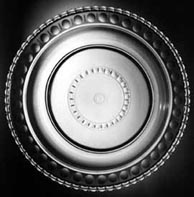- Glass Making in Roman Times
- Roman Wine: A Window on an Ancient Economy
- Roman Wine: Windows on a Lifestyle
- Fine Glassware in the Roman World
- Reuse of Images in the Art of Rogier van der Weyden
Glass in Society

Cast bowl from the Cave of Letters, Israel
Early 2nd century A.D.
D., 33.8 cm

Faceted cup
Latter part of the 1st century A.D.
Ht., 9.0 cm
Thick-walled glass vessels, either free-blown or mold-cast, could be facet-cut using a burring tool mounted on a lathe. Patterning of this kind ranged from the very simple to the extremely complex.
Documentation of the various glassworking innovations of the Neronian era does much to help us appreciate how far the skill level within this Roman industry had advanced in the mere seven or eight decades of its history. We should not imagine, however, that the position of glass changed significantly in the Roman material hierarchy over that time period. The reasonably effective mimicry of elitist silver, rock crystal, and fluorspar did not elevate the status of glass in some "by-the-bootstraps" way, or give the glassworkers themselves some new social standing.
The views held by the inherently wealthy sector of Roman society, as to what were inappropriate ways to earn a living, remained the same as those expressed by the Republican lawyer, Marcus Tullius Cicero, a century or so earlier:
"All craftsmen, too [like retail merchants], are engaged in vulgar occupations, for a workshop or factory can have nothing genteel about it." (An Essay about Duties I.150).
